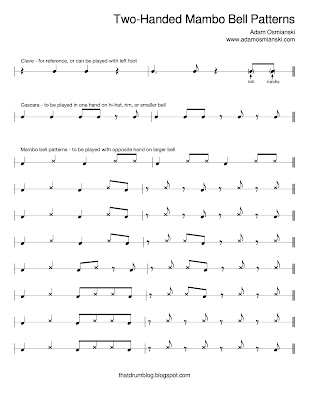Probably the most common "ride" pattern when orchestrating salsa music on the drumset is cascara:
This would traditionally be played on the shell of a timbale. A drumset player would use the ride cymbal, or the shell of a floor tom.
The left hand often then plays clave on a rim click, or would emulate the congas with a combination of rim sounds and toms.
This is a very common, functional, and effective orchestration. But at the same time it leaves our hands pretty busy, and doesn't leave us much capacity to play other parts of traditional salsa arrangements, such other bell patterns.
But if we leave out the conga pattern or clave, the cascara still carries the groove and a hand is freed up a to play another pattern. Tristan tells me this is a common orchestration, as the bongo player is often the first person to be cut when the ensemble needs to be smaller.
So now, let's move the cascara pattern to our left hand, and use our right hand to play some of the mambo bell patterns that the bongo player would have played. This can be a real roast if you spent years playing cascara in your right hand. But it's a great sound, and a fun challenge.
My personal favorite sound is with two bells: cascara on a smaller bell, and the mambo pattern on a larger mambo bell. However, if you only have one, or even no cowbells your can put the cascara pattern on your hi-hat with your left hand, and play the mambo pattern on your lone bell, or even the ride cymbal.
The examples above are common combinations, but I believe you can play pretty much any of the first bars and follow them up with any of the second bars for variety.
As you work on this, bear in mind that both the cascara pattern and the mambo bells patterns are directional, just like the clave. The sheet above is written in 2-3, so if you want to play 3-2 just start with the second bar of any of the patterns and follow it with the first bar.


No comments:
Post a Comment